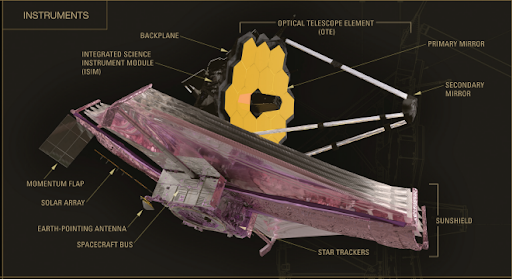James Webb Space Telescope (JWST)
Why in News:
- NASA’s James Webb Space Telescope was launched, opening a new era of astronomy.
- The telescope is an international collaboration led by NASA in partnership with the European and Canadian space agencies.
Functions of JWST
- Webb will gaze into the epoch when the very first stars and galaxies formed, over 13.5 billion years ago.
- Ultraviolet and visible light emitted by the very first luminous objects has been stretched or “redshifted” by the universe’s continual expansion and arrives today as infrared light. Webb is designed to see this infrared light with unprecedented resolution and sensitivity.
- Webb will be a powerful tool for studying the nearby universe.
- Scientists will use Webb to study planets and other bodies in our solar system to determine their origin and evolution and compare them with exoplanets, planets that orbit other stars.
- Webb will also observe exoplanets located in their stars’ habitable zones, the regions where a planet could harbor liquid water on its surface, and can determine if and where signatures of habitability may be present.
- Using a technique called transmission spectroscopy, the observatory will examine starlight filtered through planetary atmospheres to learn about their chemical compositions.
About the telescope

- The Webb telescope will reach its destination in solar orbit about 1.6 million km from Earth — about four times farther away than the moon.
- And Webb’s special orbital path will keep it in constant alignment with the Earth as the planet and telescope circle the sun in tandem.
- By comparison, Webb’s 30-year-old predecessor, the Hubble Space Telescope, orbits the Earth from about 550 km away, passing in and out of the planet’s shadow every 90 minutes.
- The instruments on board JWST have very simple functions — an infrared camera will take images of astronomical objects, while spectrometers would break the incoming infrared light into different colours for analysis.
- The new telescope’s primary mirror —consisting of 18 hexagonal segments of gold-coated beryllium metal — also has a much bigger light-collecting area, enabling it to observe objects at greater distances, thus farther back into time, than Hubble or any other telescope.
- It will bring into view a glimpse of the cosmos never previously seen — dating to just 100 million years after the Big Bang, the theoretical flashpoint that set in motion the expansion of the observable universe an estimated 13.8 billion years ago.
- Webb’s instruments also make it ideal to search for evidence of potentially life-supporting atmospheres around scores of newly documented exoplanets — celestial bodies orbiting distant stars — and to observe worlds much closer to home, such as Mars and Saturn’s moon Titan.
- JWST will also be positioned much deeper into the space, about a million miles from Earth, at a spot known as L2. It is one of the five points, known as Lagrange’s points, in any revolving two-body system like Earth and Sun, where the gravitational forces of the two large bodies cancel each other out.
- Lagrange points are positions in space where objects sent there tend to stay put. At Lagrange points, the gravitational pull of two large masses precisely equals the centripetal force required for a small object to move with them. These points in space can be used by spacecraft to reduce fuel consumption needed to remain in position . There are five such points in the Sun-Earth system and they are denoted as L1, L2, L3, L4 and L5.
- Objects placed at these positions are relatively stable and require minimal external energy to keep themselves there. L2 is a position directly behind Earth in the line joining the Sun and the Earth.
The significance
- Powerful space telescopes, like JWST or the Hubble Telescope, are often called time-machines because of their ability to view very faraway objects. The light coming from those objects, stars or galaxies, which is captured by these telescopes, began its journey millions of years earlier. Essentially, what these telescopes see are images of these stars or galaxies as they were millions of years ago. The more distant the planet or star, the farther back in time are the telescopes able to see.
- Webb is about 100 times more sensitive than Hubble and is expected to transform scientists’ understanding of the universe and our place in it.
- JWST is much more powerful and has the ability to look in the infrared spectrum, which will allow it to peer through much deeper into the universe, and see through obstructions such as gas clouds.
- As electromagnetic waves travel for long distances, they lose energy, resulting in an increase in their wavelength. An ultraviolet wave, for example, can slowly move into the visible light spectrum and the infrared spectrum, and further weaken to microwaves or radio waves, as it loses energy. Hubble was designed to look mainly into the ultraviolet and visible regions of the electromagnetic spectrum. JWST is primarily an infrared telescope, allowing it to gaze through clouds of gas and dust where stars are being born , the first of its kind.
References:
- https://www.thehindu.com/sci-tech/science/nasas-revolutionary-new-space-telescope-launched/article38036738.ece
- https://www.thehindu.com/todays-paper/tp-international/a-telescope-on-million-mile-voyage/article38039587.ece
- https://indianexpress.com/article/explained/explained-how-webb-telescope-seeks-to-unlock-universe-secrets-7689404/
- https://www.jwst.nasa.gov/content/webbLaunch/assets/documents/WebbFactSheet.pdf

[…] To read more about JWST: https://officerspulse.com/james-webb-space-telescope-jwst/ […]